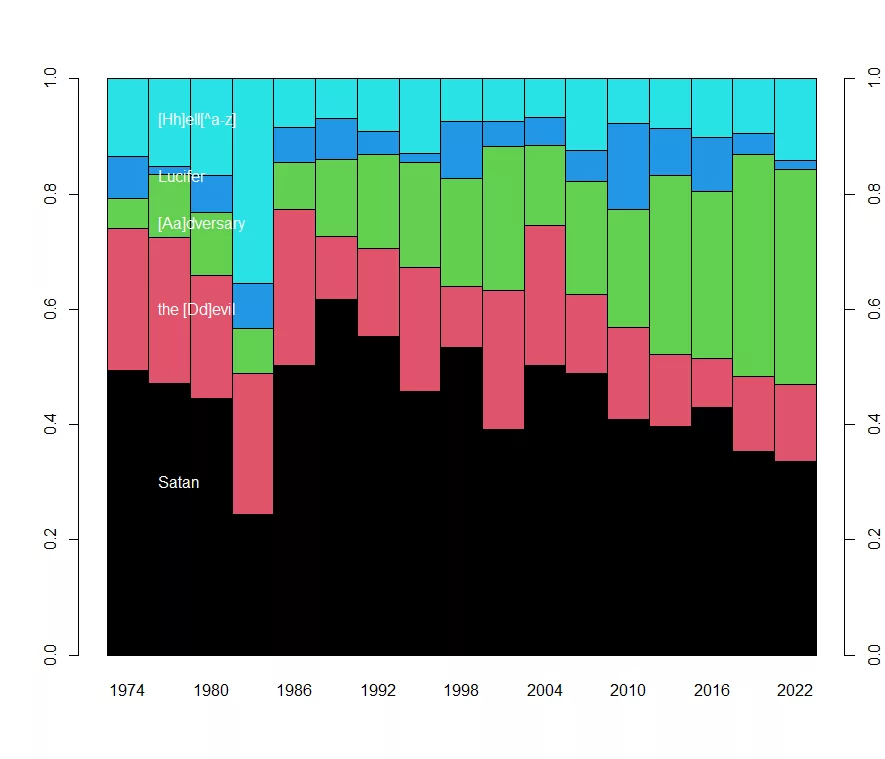Top Stories Tamfitronics
(RNS) — The Mormon Satan used to command worlds and control a third of the host of heaven. LDS theology, both official and unofficial, credited him with having power over the water, possessing people’s souls and bodiesand marshaling demons and other foul spirits to carry out his will.
He was mighty, fearsome. His domain was this entire planet and all its seats of power.
What the heck happened to him?
Now he’s become that voice of chronic self-doubt in your head, telling you that you’re not good enough, and, hey, you really ought to eat that second brownie.
Poor Satan. Or rather, I should say poor “adversary,” because that’s the preferred term we have gravitated toward. As Christian Anderson’s graph of the last half-century of General Conference language shows, in the 1970s “adversary” (in green) was rare, dwarfed by names like “Satan” (in black) and “the devil” (in red). Over time, its usage has mushroomed until “adversary” has become the most popular term.

Rise of “adversary” in LDS General Conference, 1974 to present. (Graph by Christian Anderson)
That shift in language reflects a larger move in theological focus. Recent emphases from church leaders show Satan as the great and terrible spoiler of … self-improvement projects. Here is a sampling of some General Conference talks within the last decade or so that give us hints as to Satan’s evolving job description.
- He “seeks to limit your earthly and heavenly potential” by employing tools like deception, distraction and discouragement.
- He will be relentless in his attempts to “erode (y)our personal spiritual foundation.”
- He will attack your self-esteem and make you feel you’re not good enough.
- He’ll distract you from your spiritual path and create “so much noise that it can be difficult to hear the Lord’s voice.”
- He is “pleased when parents neglect to teach and train their children to have faith in Christ and be spiritually born again.”
- He tries to “weaken … faith and instill disbelief” in your heart.
- He “takes every opportunity” to fill your mind “with images of violence and immorality.”
- He instills “feelings of fear” that prevent you from doing missionary work.
- He is ready to pounce and “establish a foothold in (y)our homes” if you fail to study the Scriptures together as a family.
- He will “perpetuate a very real sense of panic” that undermines your ability to see yourself and your family members with an eternal lens.
What all of these have in common is an inward, therapeutic turn toward the self. The adversary now exists to bring individual adversity. In fact, congratulations! He will tailor-make such adversity for each person. He thrives on building hyper-personalized obstacle courses that will trip us up.
To be fair, there’s always been a partial focus on Satan as an individual tempter. The Hebrew word satan (sah-TAHN) means “adversary” or “opponent,” and the idea of Satan as a personal adversary is attested to in the Hebrew Bible, most famously in the Book of Job.
It’s also in the very foundations of the LDS story, since a young Joseph Smith reported being attacked by Satan in the First Vision.
The difference is that in the past, Satan was depicted as both an individual tempter and a cosmic force that could control the elements of nature and bring down whole nations. Today, he’s not both/and so much as either/or. We don’t speak of him exerting physical power over this world, or of seeking to sabotage anything larger than our very own personal spiritual journey.
It is, in the end, all about us.
What’s particularly fascinating about this domestication is that it comes from some of the very people who would be the first to insist Satan is real, and who would view denying that reality as a dangerous path. I certainly don’t hear church leaders denying the reality of Satan. But I do hear, again and again, them adopting language that so curtails his sphere of influence that it achieves a similar shrinkage.
For example, the topical entry on Satan on the church’s website teaches:
Heavenly Father allows Satan and Satan’s followers to tempt us as part of our experience in mortality. Because Satan “seeketh that all men might be miserable like unto himself,” he and his followers try to lead us away from righteousness. He directs his most strenuous opposition at the most important aspects of Heavenly Father’s plan of happiness. For example, he seeks to discredit the Savior and the priesthood, to cast doubt on the power of the Atonement of Jesus Christ, to counterfeit revelation, to distract us from the truth, and to contradict individual accountability. He attempts to undermine the family by confusing gender, promoting sexual relations outside of marriage, ridiculing marriage, and discouraging childbearing by married adults who would otherwise raise children in righteousness.
Individuals do not have to give in to Satan’s temptations. Each person has the power to choose good over evil, and the Lord has promised to help all who seek Him through sincere prayer and faithfulness.
In this description, Satan is primarily concerned with disrupting individual happiness and success in the gospel. When he does venture into broader social issues, those issues are — surprise, surprise — the very same ones LDS church leaders are also concerned about in this particular cultural moment, especially nonbinary gender identity and the weakening of social commitments to marriage and childbearing.
What a sad and sorry downfall Satan has had. Let’s all take a moment to extend the guy some sympathy. He’s the one sitting over there at the French café, smoking cigarettes and wrestling with the kind of ennui that it’s now his sole purpose to inflict upon you.
Right now, he’s telling the other café patrons and, well, anyone who will listen, that he used to be great.
He could have been a contender.
Related content:



